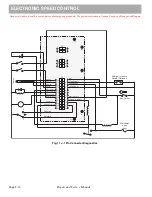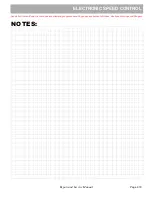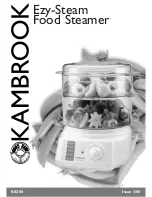
Page G-2
Repair and Service Manual
B
BRAKES - FRONT DISC
Read all of Section B and this section before attempting any procedure. Pay particular attention to Notices, Cautions, Warnings and Dangers.
BRAKE MASTER CYLINDER FLUID
Hydraulic brake systems must be totally flushed if the fluid
becomes contaminated with water, dirt or other corrosive
chemicals. To flush, bleed the entire system until all brake fluid
has been replaced with fresh DOT 3 standard automotive
brake fluid.
Check Brake Fluid
The brake fluid should be checked at regular intervals
(as specified in the Periodic Service Schedule) or imme-
diately if fluid leaks are found. The easiest way to check
fluid level is to clean the cap with a shop rag and remove
the cap. Check fluid level using a mechanics mirror and
a flashlight. Add fluid if the level has fallen below 1/4”
from the top of the reservoir and inspect for visible fluid
leaks.
ROUTINE MAINTENANCE
Tool List
Qty.
Shop Rag................................................................. A/R
Mechanics Mirror ......................................................... 1
Flashlight ..................................................................... 1
Transmission Fluid Funnel........................................... 1
Torque Wrench ft. lbs................................................... 1
Torque Wrench in. lbs.................................................. 1
Crows Foot 9/16” ......................................................... 1
Open end Wrenches 3/8”,
1/2”, 5/8”, 9/16”.................. 1
Needle Nose Pliers...................................................... 1
Ratchet ........................................................................ 1
Sockets 3/8”,
1/2”, 5/8”, 9/16” ...................................... 1
Micrometer/Vernier Caliper.......................................... 1
2” C Clamp .................................................................. 1
Floor Jack .................................................................... 1
Jack Stands ................................................................. 1
Ball Joint Seperator ..................................................... 1
Lug Wrench, 3/4" ......................................................... 1
Jack ............................................................................. 1
Jack stands.................................................................. 4
Brake adjusting tool ..................................................... 1
Plastic faced hammer .................................................. 1
Never work on a vehicle supported by a jack
alone. To prevent possible personal injury, the
vehicle must be supported on jack stands dur-
ing this procedure.
REPLACEMENT OF WEAR ITEMS
Brake Pad Replacement
Brake pads should always be replaced as a full set of
four pads. To remove the brake pads, raise the vehicle
per ‘Lifting the Vehicle’ in the SAFETY section. Loosen
both of the bolts securing the caliper to the spindle but
only remove one. Swing the caliper free from the rotor.
Push out the two guide/retainer pins from the caliper and
remove the pads, being careful to note the orientation of
the brake pads. Install a new set of pads. If the pads
have been correctly oriented, the guide pins will easily
engage. Re-insert the guide/retainer pins, being sure
that they are correctly seated in the grooves machined
in the caliper casting. Gently push the pads away from
each other to provide adequate clearance with the rotor
and then swing the entire caliper and pad assembly
back over the rotor. Secure the caliper to the spindle and
tighten both bolts to 25 - 30 ft. lbs. (33.8 - 40.6 Nm)
torque. NOTE: Unless fluid is lost or a brake line is dis-
connected, there is no need to bleed the system.
Rotor Replacement
The rotor (disc brake hub) is not designed to be trued
(“turned”).
If the rotor has deep grooves or gouges, it must be
replaced. If the pad contact area has worn the rotor to
.120” or less, the rotor must be replaced.
If the rotor must be replaced (or serviced), the caliper
and pads must be swung out of the way to gain access
to the rotor (See Brake Pad Replacement).
The disc hub (rotor) can be serviced in the same manner
as the hub on non-front disc brake equipped vehicles.
For Hub Replacement, Wheel Bearing and Race
Replacement, Wheel Bearing Packing and Wheel Bear-
ing Adjustment procedures, see FRONT SUSPENSION
AND STEERING.
Spindle Replacement
See FRONT SUSPENSION AND STEERING.
Actuator Linkage Bushings
Removing the front shield may improve access (See
BODY)
The actuator linkage is connected to the lower actuator
pivot with a flat washer and cotter pin. Remove and dis-
card the cotter pin and remove the washer. A new nylon
NOTICE
NOTICE
Содержание Shuttle 2
Страница 6: ...Page iv Repair and Service Manual NOTES TABLE OF CONTENTS ...
Страница 195: ......
















































